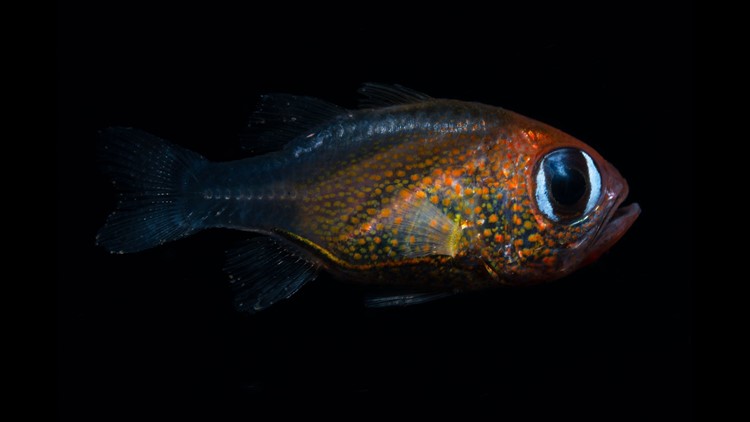(CNN) — The quest for the unknown revealed exciting new discoveries this year. California Academy of Sciences researchers discovered 71 new animal and plant species in 2019.
The list includes flowers, fish, corals, spiders, sea slugs, ants and lizards, among others. They were found across three oceans and five continents in caves, forests and even the greatest depths of the ocean.
Learning more about these intriguing new species allows for a greater understanding of environments and biomes, as well as targeted conservation efforts.
“Despite decades of tirelessly scouring some of the most familiar and remote places on Earth, biodiversity scientists estimate that more than 90% of nature’s species remain unknown,” said Academy Chief of Science Shannon Bennett. “A rich diversity of plants and animals is what allows life on our planet to thrive: The interconnectedness of all living systems provides collective resilience in the face of our climate crisis. Each newly discovered species serves as an important reminder of the critical role we play in better understanding and preserving these precious ecosystems.”
Here’s a look at some of the new species.
A fish called Wakanda
Although the nation of Wakanda exists only in the Marvel Comics universe as superhero Black Panther’s home, researchers believe they have found a version of it underwater. In secretive reefs 260 feet below the surface, these warriors — accented with vibrant purple — are fish.
Previously unknown, the fish species lives in dark coral reefs, called “Twilight Zone” reefs, in the Indian Ocean off the coast of Tanzania. The fish are a new species of what’s known as fairy wrasses.
Their scales are so deeply pigmented that the deep purple remains even when preserved for research, when color is usually lost.
The fish were named Cirrhilabrus wakanda, or the vibranium fairy wrasse, in honor of Wakanda and “Black Panther.”
“When we thought about the secretive and isolated nature of these unexplored African reefs, we knew we had to name this new species after Wakanda,” said Yi-Kai Tea, lead author of the study and an ichthyology Ph.D. student from the University of Sydney. “We’ve known about other related fairy wrasses from the Indian Ocean but always thought there was a missing species along the continent’s eastern edge. When I saw this amazing purple fish, I knew instantly we were dealing with the missing piece of the puzzle.”
Researchers found 16 other new species of fish this year, including a cat-eyed cardinalfish.
Endangered lizards and geckos
In 2019, Aaron Bauer, an Academy Research Associate, found 15 mottled geckos, an orange lizard, a girdled lizard and three skinks — and most of them are essentially endangered. That’s because all of them are found in very small geographic areas so any upset, like deforestation, can deplete their numbers.
Finding these species in time, and determining the threats to their populations, is key. For example, one of the island-dwelling skinks Bauer found is threatened by an invasive species of fire ants.
“If we don’t explore isolated habitats, like mountaintops, we would miss a huge part of the biodiversity that’s unique to these regions,” Bauer said. Over the course of his career, he has discovered more than 205 reptiles.
Surprising sea slugs
Sea slugs are masters of disguise. A newly discovered species, Madrella amphora, actually resembles snail eggs that can be found in their habitat.
“We recently confirmed through genetics that sea slugs mimic the colors of other species, but it’s rare to see sea slugs mimic other animals entirely,” said Terry Gosliner, Academy Curator of Invertebrate Zoology. Gosliner is known for a number of discoveries regarding sea slugs.
Researchers also found five other types of colorful sea slugs with quirky disguises, unique colors and small sizes compared to their other well-known counterparts.
Delicate flowers
A number of surprising things have been determined about plants over the years, like the fact that they communicate with each other and complain about drought. And in the case of a rare flowering plant spotted this year, they keep researchers on their toes by moving around.
Trembleya altoparaisensis is a lovely plant with white flowers that was initially collected only once more than 100 years ago by Auguste François Marie Glaziou, a famed botanist. Trying to track it down in modern times to actually describe the plant proved difficult.
“People don’t think plants move, but they do,” said Ricardo Pacifico, a PhD student working with Frank Almeda, emeritus curator of botany at the Academy. This is because plants have to look after their needs as environments change, so they migrate.
They found Trembleya altoparaisensis living in Chapada dos Veadeiros National Park’s canyons in Brazil.
In total, eight flowering plants, including a new species in one of Madagascar’s national parks, were found this year.
Deep sea coral
Remotely operated vehicles are helping researchers discover and understand coral found during deep sea surveys. A 2018 NOAA expedition revealed a beautiful yellow coral called Chromoplexura cordellbankensis off the coast of California.
“We know the intertidal zone, but the deep sea is out of sight, out of mind,” said Gary Williams, invertebrate zoology curator at the Academy.
Two new diverse corals were found this year in the Cordell Bank National Marine Sanctuary, 60 miles from San Francisco’s coast.
Freaky spiders
Researchers spotted five new spiders this year, and some of them are pretty strange.
One is a family of “ant-worshipping” spiders that live in ant mounds — although the reason for that remains to be seen. Researchers found them in the Chihuahuan desert in Mexico, spotted in an array around an ant nest that had collapsed. Otherwise they’re usually underground.
“The only way to see what they’re doing is to dig them up. But then they’re no longer in their natural state,” said Darrell Ubick, Academy Curatorial Assistant of Entomology.
They also found new harvestmen — organisms related to spiders — living in caves and adapted to life in the dark. They were found in Croatia, helping inform the way species branch off using different adaptations.
Skate party
Skates are fish that look like rays. Many can be found off the Falkland Islands, living at depths of nearly 2,000 feet.
They’re also cut into steaks or fermented in Korea. But some of the species ending up in markets may actually be a newly discovered species called Dipturus lamillai.
The discovery could help with conservation efforts so that new species aren’t overfished before they can be understood, the researchers said.



